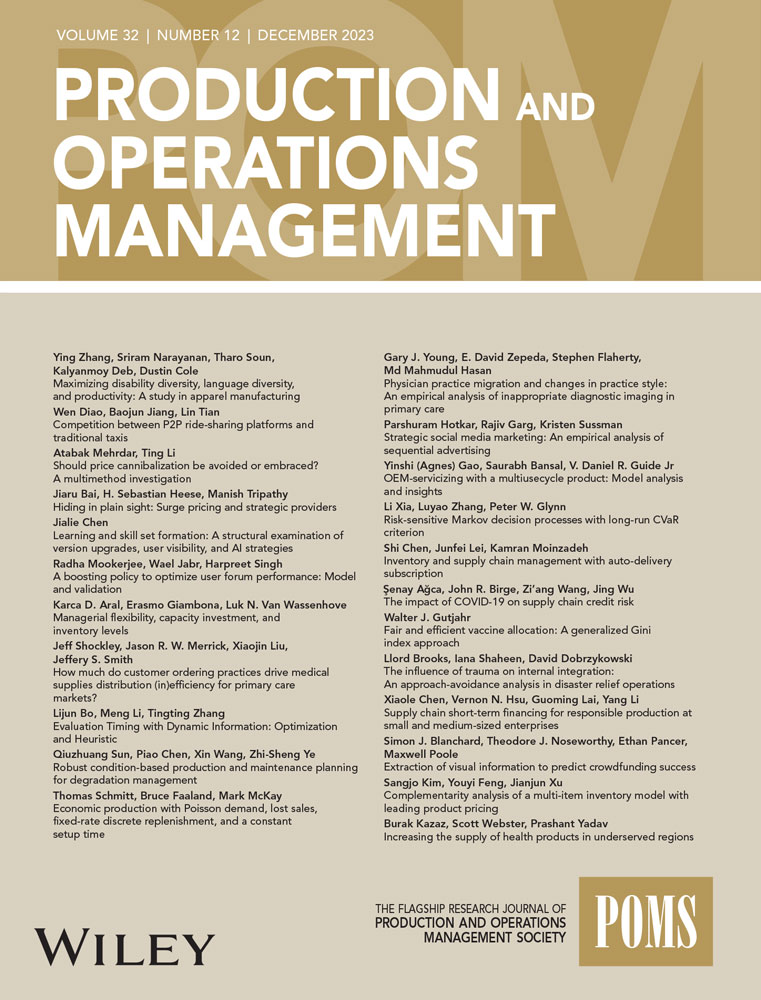需求不确定性下麻醉师公平调度的多目标规划
IF 5.1
3区 管理学
Q1 ENGINEERING, MANUFACTURING
引用次数: 0
摘要
摘要本工作解决了实际麻醉师调度(AS)的问题,由学术麻醉科的需求驱动。AS问题要求该部门在长达数周的规划范围内计划和部署提供者,以充分满足临床需求和各种临床单位的机构协议。通过利用麻醉病例的历史需求数据,开发了一个数据驱动的两步AS框架。第一步是班次设计,考虑不确定条件下的临床需求,使用条件值风险约束获得最佳班次;第二步是使用多目标混合整数规划模型,考虑最佳和公平的工作量分配和提供者可用性,生成时间表的提供者分配。此外,AS框架结合了提供者的专业、临床和生活方式偏好,并与现有的调度实践保持一致。提出了一种基于约束的多目标优化求解方法,并提出了一种迭代求解方法,以提高临床应用中工作量公平的求解质量。计算实验对三种不同形式的工作负载公平目标函数的性能进行了评估,结果表明,提供商工作负载绝对偏差之和的最小化最能平衡解决方案的运行时间和质量。在有关的学术麻醉科,通过应用拟议的AS框架,解决了两个临床问题,即预算和招聘计划以及每月调度。对于预算和招聘,决策者可以根据自己的偏好,使用通过约束方法获得的非支配边界进行权衡。对于每月的日程安排,迭代解决方法可以适应预先分配的班次,在提高工作量公平的同时捕获机构需求。基于历史进度数据,在实现之后,工作负载差异从2.92大幅减少到1.39。供应商的调度满意度从3.13/5提高到3.44/5,减轻了部门领导至少82%的调度负担。开发的AS框架是通用的,可以扩展到其他类型的护理提供者的调度,包括护士和住院医生。本文章由计算机程序翻译,如有差异,请以英文原文为准。
Equitable anesthesiologist scheduling under demand uncertainty using multiobjective programming
Abstract This work addresses the practical anesthesiologist scheduling (AS) problem motivated by the needs of an academic anesthesiology department. The AS problem requires the department to plan and deploy providers to adequately meet clinical demand and institutional protocols of various clinical units over a planning horizon of up to several weeks. A data‐driven two‐step AS framework is developed by exploiting the historical demand data of anesthesia cases. The first step is a shift design which obtains the optimal shifts considering clinical demand under uncertainty using conditional value‐at‐risk constraints, and the second step is provider assignments that generate the schedule considering optimal and equitable workload distribution and provider availability using multiobjective mixed‐integer programming models. Moreover, the AS framework incorporates the provider specialties, and clinical and lifestyle preferences and aligns with the existing scheduling practices. An ɛ‐constraint solution method is applied for multiobjective optimization, and an iterative solution method is developed to improve solution quality for workload equity in clinical applications. Computational experiments are performed to evaluate the performance of three alternative forms of the workload equity objective function, and the results show that the minimization of the sum of the absolute deviations of provider workloads best balances solution runtime and quality. In the concerned academic anesthesiology department, two clinical problems, the budget and hiring planning and the monthly scheduling, are addressed via the application of the proposed AS framework. For budget and hiring, decision‐makers can make trade‐offs based on their preference using the nondominated frontiers obtained via the ɛ‐constraint method. For monthly scheduling, the iterative solution method can accommodate preassigned shifts capturing institutional requirements while improving workload equity. The workload variance has been substantially reduced from 2.92 to 1.39 after the implementation based on the historical schedule data. The provider schedule satisfaction is improved from 3.13/5 to 3.44/5, and at least 82% of scheduling burden on department leaders is relieved. The developed AS framework is generic and can be extended to the scheduling of other types of care providers, including nurses and residents.
求助全文
通过发布文献求助,成功后即可免费获取论文全文。
去求助
来源期刊

Production and Operations Management
管理科学-工程:制造
CiteScore
7.50
自引率
16.00%
发文量
278
审稿时长
24 months
期刊介绍:
The mission of Production and Operations Management is to serve as the flagship research journal in operations management in manufacturing and services. The journal publishes scientific research into the problems, interest, and concerns of managers who manage product and process design, operations, and supply chains. It covers all topics in product and process design, operations, and supply chain management and welcomes papers using any research paradigm.
 求助内容:
求助内容: 应助结果提醒方式:
应助结果提醒方式:


